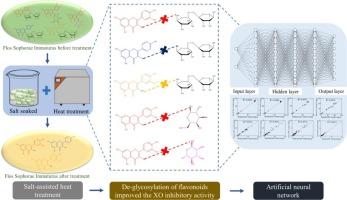氯化钾辅助热处理可提高槐黄酮的去糖基化效率和黄嘌呤氧化酶抑制活性
IF 6.5
1区 农林科学
Q1 CHEMISTRY, APPLIED
引用次数: 0
摘要
盐辅助热处理被认为是提高Flos Sophorae Immaturus茶(FSIt)中黄酮类化合物生物活性的有效方法。本文采用氯化钠(NaCl)和氯化钾(KCl)辅助热处理的方法处理花茶,记录了花茶中黄酮类化合物的成分、黄嘌呤氧化酶(XO)抑制活性、降解或转化动力学。结果表明,KCl辅助热处理可将FSIt的XO抑制率从28.05%显著提高到69.50%。黄酮类化合物的去糖基化是提高 XO 抑制活性的关键原因。值得注意的是,氯化钾对去糖基化反应的催化作用优于氯化钠。同时,转化动力学表明,槲皮素、山柰醇和异鼠李素的生成率分别在 180、160 和 160 ℃ 时达到最大值。此外,所建立的人工神经网络模型可以准确预测盐辅助热处理过程中 FSIt 类黄酮的变化。因此,氯化钾可作为一种有价值的食品加工辅助剂来提高食品材料的生物活性。本文章由计算机程序翻译,如有差异,请以英文原文为准。

Potassium chloride-assisted heat treatment enhances the de-glycosylation efficiency and xanthine oxidase inhibitory activity of Sophora japonica L. flavonoids
Salt-assisted heat treatment is considered an effective way to enhance the bioactivities of flavonoids in Flos Sophorae Immaturus tea (FSIt). Herein, sodium chloride (NaCl)- and potassium chloride (KCl)-assisted heat treatment was employed to process FSIt, the components, xanthine oxidase (XO) inhibitory activity, and degradation or conversion kinetics of FSIt flavonoids were recorded. Results showed that KCl-assisted heat treatment significantly increased the XO inhibition rate of FSIt from 28.05 % to 69.50 %. The de-glycosylation of flavonoids was the crucial reason for enhancing XO inhibitory activity. Notably, KCl exhibited a better catalytic effect on the de-glycosylation reaction than NaCl. Meanwhile, conversion kinetics showed that the generation rate of quercetin, kaempferol, and isorhamnetin reached the maximum at 180, 160, 160 °C, respectively. Furthermore, the established artificial neural network model could accurately predict the changes of FSIt flavonoids during salt-assisted heat treatment. Thus, KCl can be used as a valuable food processing adjuvant to enhance the bioactivities of food materials.
求助全文
通过发布文献求助,成功后即可免费获取论文全文。
去求助
来源期刊

Food Chemistry: X
CHEMISTRY, APPLIED-
CiteScore
4.90
自引率
6.60%
发文量
315
审稿时长
55 days
期刊介绍:
Food Chemistry: X, one of three Open Access companion journals to Food Chemistry, follows the same aims, scope, and peer-review process. It focuses on papers advancing food and biochemistry or analytical methods, prioritizing research novelty. Manuscript evaluation considers novelty, scientific rigor, field advancement, and reader interest. Excluded are studies on food molecular sciences or disease cure/prevention. Topics include food component chemistry, bioactives, processing effects, additives, contaminants, and analytical methods. The journal welcome Analytical Papers addressing food microbiology, sensory aspects, and more, emphasizing new methods with robust validation and applicability to diverse foods or regions.
 求助内容:
求助内容: 应助结果提醒方式:
应助结果提醒方式:


